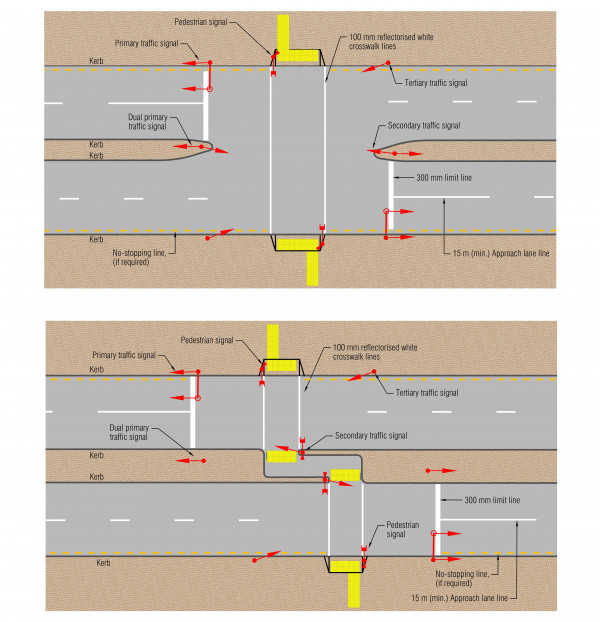This section provides guidance on signalised pedestrian crossings at mid-block locations. Guidance on pedestrian crossings at signalised intersections is available in TCD manual Part 4.
Section 8.5 of the TCD rule states that:
(1) [If pedestrian signals are installed], markings must be installed to guide the movement of pedestrians
(2) A road controlling authority may not mark a pedestrian crossing (zebra) in an area controlled by traffic signals
(3) A road controlling authority may install pedestrian signals complying with Section 6 [of the TCD Rule] to control the movement of pedestrians at locations other than intersections.
The specific details for the application of pedestrian signals are contained within section 6 of the TCD Rule and apply to both intersections and mid-block crossings.
Clause 6.6(3A) of the TCD Rule states:
(3) A countdown pedestrian signal, comprising a white or yellow display (conforming to the description in Schedule 3) showing the number of seconds remaining in the pedestrian clearance period, may only be installed beside pedestrian traffic signals at:
(a) mid-block pedestrian traffic signals; or
(b) intersections where all of the approaches to the area controlled by traffic signals are controlled by red signals at the same time while pedestrians are permitted to cross.
Clause 6.6(4) of the TCD Rule states:
(4) Except as provided in 6.6(5), pedestrian traffic signals must operate in the following sequence:
(a) a steady green walking human figure symbol to indicate the period during which a pedestrian is allowed to enter a roadway followed by a flashing red standing human figure symbol to indicate the period during which a pedestrian is expected to finish crossing a roadway;
(b) either the display at (a) or a steady red standing human figure, displayed for at least two seconds, to indicate when a pedestrian must not enter a roadway followed by;
(c) the display at (a); or
(d) blank display followed by:
(i) the display at (a); or
(ii) a steady red standing human symbol followed by the display at (a).
Clause 6.6(5) of the TCD Rule states:
(5) A nearside pedestrian traffic signal may only be installed at mid-block pedestrian traffic signals and must operate in the following sequence:
(a) a steady green walking human figure symbol to indicate the period during which a pedestrian is allowed to enter a roadway [display A] followed by;
(b) a steady red standing human figure, displayed for at least two seconds, to indicate when a pedestrian must not enter a roadway followed by […]:
(c) the display at (a); or
(d) a blank display followed by:
(i) the display at (a); or
(ii) a steady red standing human symbol followed by the display at (a).
The details for the implementation of signal controls at intersections are TCD manual Part 4, which should be referred to.
Signalised pedestrian crossings may be desirable at mid-block locations where:
Detailed information on their use is provided within the Pedestrian network guidance (PNG).
For typical markings, refer to Figure 7‑16 below.
Figure 7‑16
Table 7‑7: Specifications for pedestrian crossing markings
| Colour | Reflectorised white |
|---|---|
| Line width | 100mm |
| Stripe | Continuous |
| Pedestrian crossing width (see note 1) |
2.0m (minimum) ≥2.5m (desirable) |
Table 7-7 notes:
For information on sign specifications such as sign size, reflectivity and legend details refer to the TCD manual sign specifications.
Typical layouts for single stage and staggered signalised pedestrian crossings are shown in Figure 7‑16
Figure 7‑16: Typical layouts for single stage and staggered signalised mid-block pedestrian crossings (signalised)
